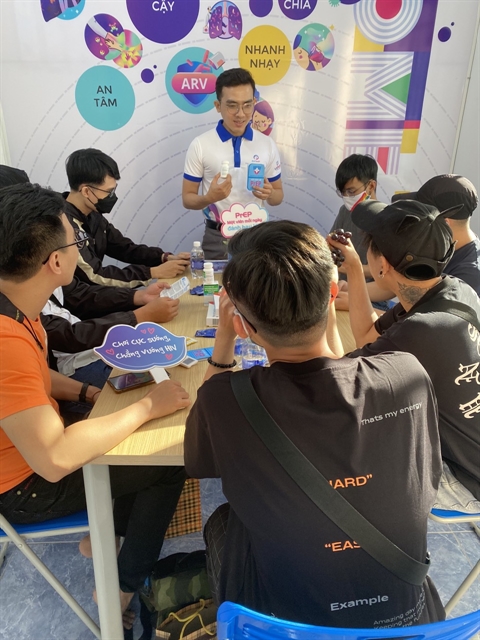 Society
Society

 |
| A CBO staff member offers counselling related to HIV/AIDS prevention and treatment at a health services shop piloted under the community one-stop shop model called DOME in HCM City. — Photo courtesy of LIFE |
HCM CITY — Community-based organisations (CBOs) are boosting coverage of HIV/AIDS prevention and treatment services for key population groups to help achieve targets for HIV/AIDS epidemic control in Việt Nam.
Phan Thị Thu Hương, head of the Việt Nam Administration for HIV/AIDS Control (VAAC), said that at a recent workshop on strengthening cooperation between CBOs and the health sector in response to the HIV/AIDS epidemic in the country, co-organised by the Centre for Promotion of Quality of Life (LIFE) and VAAC in HCM City.
She said the community-public partnership model, or C2P, a collaboration between CBOs and the health sector in HIV/AIDS prevention and control, was an initiative of LIFE that had been implemented effectively to optimise client outcomes in many provinces and cities over the past years.
“It helps improve the quality of HIV-related services provided in the community and promote closer collaboration between COBS and public health facilities,” she said.
"In the context of limited human resources in the health sector, C2P is an optimal solution to take advantage of available resources from the community and is expected to expand to other health services," she added.
Nguyễn Nguyên Như Trang, director of LIFE, said seven cooperation agreements had been signed between LIFE with the centres for disease control (CDC) in provinces and cities over the past eight years.
And 28 cooperation agreements were signed between CBOs with health facilities in HCM City, Hà Nội, Đồng Nai, Bình Dương, Cần Thơ, Bà Rịa-Vũng Tàu and Khánh Hòa.
C2P helps to increase the efficiency of transferring customers to receive anti-retroviral (ARV) treatment and take pre-exposure prophylaxis (PrEP) drugs at health facilities, according to LIFE.
From 2020 to June 2022, 71 per cent of ARV and PrEP customers being treated at health facilities signed C2P cooperation agreements in HCM City.
It has also supported nearly 5,500 patients in HCM City and Đồng Nai with treatment compliance during the social distancing period due to the COVID-19 pandemic.
At the workshop, the US Acting Consul General in HCM City Graham Harlow congratulated LIFE for successfully connecting, building, formalising and nurturing the collaboration between CBOs and health facilities.
“Because of your efforts, health facilities and provincial health authorities who have deployed this model have experienced the positive contributions of CBOs in case finding and client support,” he said.
Over the past several years, with support from the United States President's Emergency Plan for AIDS Relief (PEPFAR) through the United States Agency for International Development (USAID), LIFE’s C2P is now being actively utilised in HCM City, Hà Nội and Đồng Nai Province.
“It helps improve client access, care, and service quality,” he said.
The model had also been shown to be adaptable when responding to other health emergencies, such as the COVID-19 pandemic, he said.
During COVID-19 lockdowns, CBOs used the model to maintain support to key populations.
When clients were unable to move freely, LIFE was instrumental in working with local health authorities and health facilities to authorise CBO staff to deliver lifesaving drugs to people living with HIV.
Võ Hải Sơn of VAAC said the estimated number of people living with HIV in the country was 242,000.
Last year, the number of new cases of HIV infection was 13,223, including 1,856 deaths.
The rate of new infections in males is much higher than that in females, and are mainly drug users, prostitutes, transgender women and men who have sex with men (MSM), according to VAAC.
Unprotected sex with a partner carrying the infection is the most common form of transmission of HIV.
Mobilising the participation of the community is one of the goals outlined in the national strategy to end AIDS by 2030.
“It is necessary to create a favourable legal environment, build incentive financial mechanisms, and improve the capacity of CBOs to effectively participate in providing services in HIV/AIDS prevention and control,” Sơn said.
Supported by LIFE, more than 40 CBOs across the country provide counselling and tests for nearly 40,000 people at risk of HIV, and support 10,000 people accessing the PrEP programme each year.
Of that figure, there are about 4,000 HIV-positive cases detected, and about 98 per cent of them receive treatment every year. — VNS




